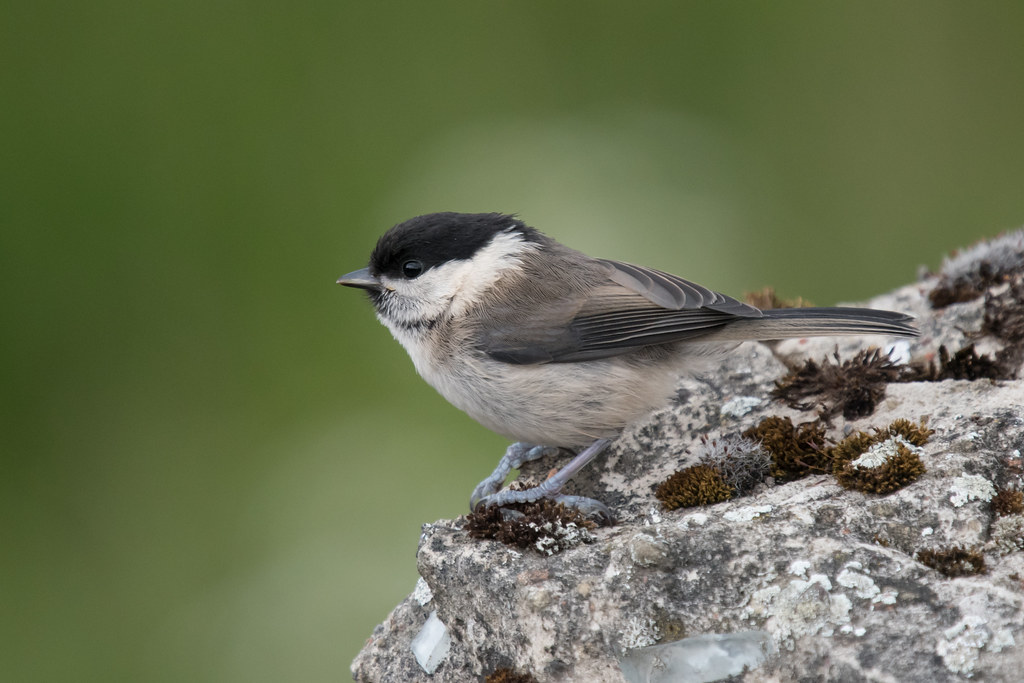
Tim writes: this is a recently-fledged Willow Tit that I found on 9th June this year. It was one of a brood of four youngsters being chaperoned by both parents, although they were constantly moving so it could possibly have been five youngsters and one parent. They were contact calling constantly as they slowly moved, but sometimes they were separated by 10m or more, making them difficult to count. Usually they kept hidden in foliage but as they moved across a gap, each of them perched momentarily on a wall. The youngsters looked very similar to the adult(s) but were maybe a tad darker and lacking an obvious pale wing panel. There was also a yellow “feed me” gape at the corner of their beaks, just visible here through the cheek feathers if you zoom right in. If anyone is doubting the identification here’s one of an adult (with an obvious pale wing panel) feeding a youngster: https://www.flickr.com/photos/timmelling/50015400092/sizes/l/
Willow Tits are now the most rapidly declining resident bird in the UK. The British population fell by 94% between 1970 and 2012. Research on reasons for the decline is ongoing, but we know they prefer scrub to woodland, and also need standing dead wood as they excavate their own nest holes. We also know that they don’t move very far and don’t like to break cover, so connectivity of their scrubland habitats may be an issue. The endemic British race kleinschmidti is the smallest and darkest of numerous races across Europe and Asia. It has deeper colour on the upperparts but the underparts are most distinctive with a buff wash on the underparts. The latest population estimate of the British kleinschmidti is 3400 pairs, but it continues to decline. Even this year the lowland Yorkshire population seems to have crashed whereas those in the hills like this one, still seem to be doing ok. This one was next to a reservoir on the West/South Yorkshire border not far from Penistone.
Mark writes: Paul Leyland has a ‘lack of internet’ situation. Back next week – I hope!
[registration_form]
A lovely little bird, As I Understand it it’s range extends right up to northern Norway . It certainly seems to be retreating northwards. Perhaps it is competition from others birds and animals that is part of the problem with global warming driving it. Great spotted wood peckers can be very predatory.
Thanks Alan. Its range does extend to northern Norway and right across the taiga zone of Russia. This is the British subspecies kleinschmidti which is a bit smaller and darker, and has a breeding population of just 2750 pairs. Compare that with 3.4 million territories of Blue Tit in Britain. You are right about predation by Woodpeckers too. The young are noisy so attract attention, and the nest is invariably in soft wood as the adults excavate the nest hole themselves. But they avoid woodpeckers through habitat. In Britain they are a bird of scrubland and abandon areas when trees get large enough to support Great Spotted Woodpeckers.
I’ve heard it suggested than in addition to predation by GSW they may also suffer from eviction by Great Tits. Any idea if this is correct?
I think it is certainly possible as Great Tits will evict anything smaller if they can fit in the nest hole. But the Willow Tit nests I have found are usually in surprisingly thin branches, and often low down, so not ideal for Great Tit. But the oval-shaped nest hole does look large enough to let in Great Tit.
I think i have mentioned before, how when we were kids Willow Tit favoured Elder for nesting in,
you could spot the excavated chips on the ground.
I can remember seeing Blue Tit using nest holes, but cant recall if they were freshly excavated.
An interesting account of the ‘discovery’ of the Willow Tit, in the UK, can be found in Brigadier
Clive Simsons ‘A Bird Overhead’.